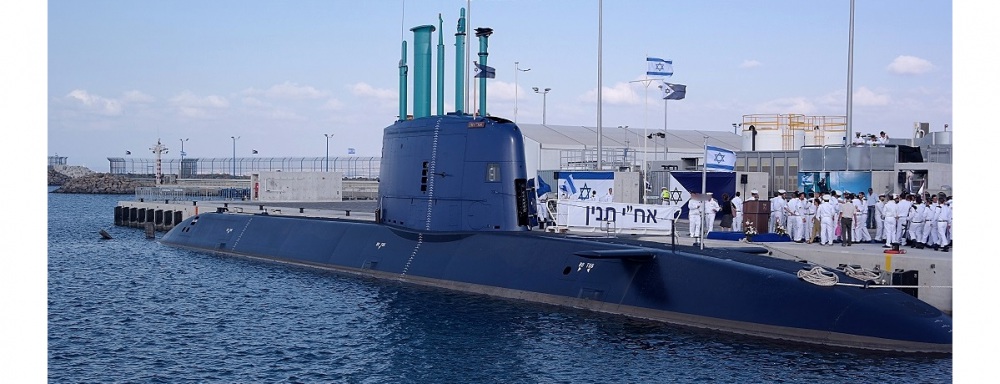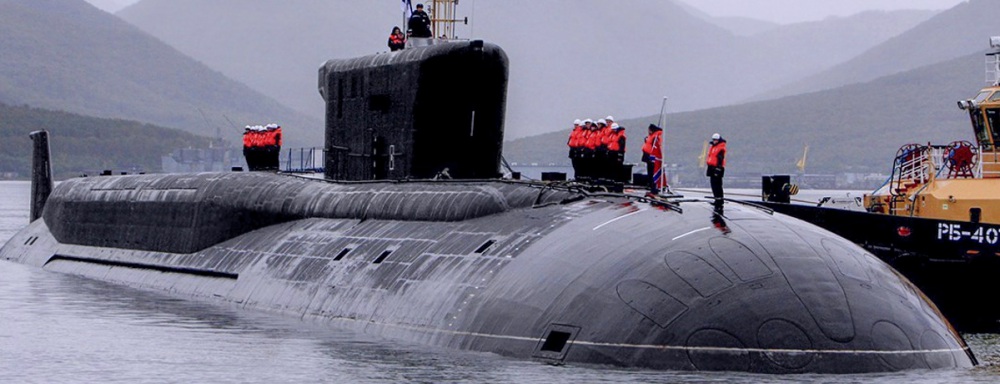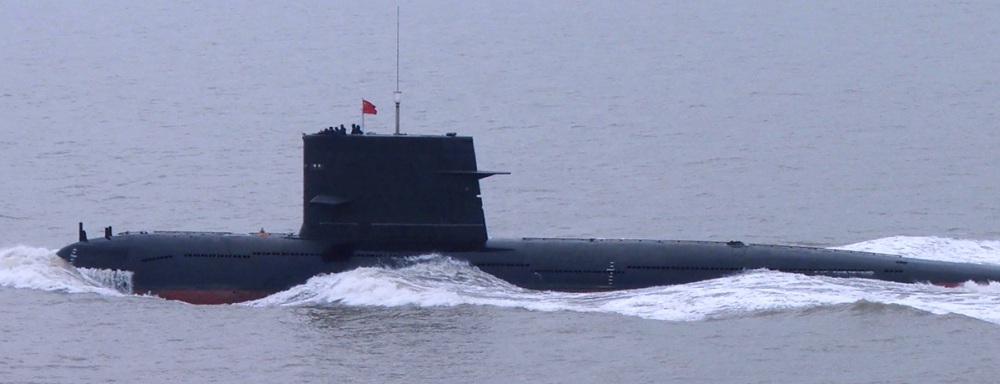
About the image
Capabilities at a Glance
Based at Haifa, the Israeli Navy (IN) currently operates five modern diesel-electric Dolphin-class submarines. All were designed and constructed by Germany’s Howaldtswerke-Deutsche Werft (HDW).1
Total Submarines in Fleet: 5
- Ballistic Missile Submarines (SSBNs): 0
- Nuclear-Powered attack submarines (SSNs): 0
- Diesel-electric attack submarines (SSKs): 5
- Air-independent propulsion (AIP) enabled: 2/5 (INS Tanin and INS Rahav)
Submarines
History
Israel first acquired two British S-class submarines in the late 1950s. Israel utilized these submarines in its wars with Lebanon from 1967 to the 1980s, but the vessels were noisy and barely fit in the Mediterranean Sea. After the S-class, the Israeli Navy depended upon three Gal-class submarines, designed by Germany for Israel, and constructed at the Vickers Shipyard in the United Kingdom between 1973 and 1977. The Gal-class vessels were a modified Type 206A coastal submarine.2
Between 1999 and 2000, Israel commissioned three Dolphin class submarines from German company Howaldtswerke-Deutsche Werft (HDW).3 Germany donated two of these vessels but split the cost of the third with Israel. The fourth and fifth submarines, agreed to in 2006, are advanced Dolphin-class vessels equipped with air-independent propulsion (AIP). The INS Tanin was commissioned in September 2014 and the INS Rahav was commissioned in 2016.4
There is consistent speculation that Israel’s submarines have been refitted to carry missiles armed with nuclear weapons for the country to maintain a survivable second-strike option.5 The German government has refused to comment on modifying the Dolphin-class submarines delivered to Israel to fit cruise missiles armed with nuclear warheads.6 However, German officials such as former Head of the Policy Planning Staff of the German Ministry of Defense Hans Rühle, have stated that they assumed Israel intended to equip the submarines with nuclear weapons.7
In June 2002, former U.S. State Department and Pentagon officials confirmed that the U.S. Navy observed Israeli missile tests in the Indian Ocean in 2000, and that the Dolphin-class vessels have been fitted with nuclear-capable cruise missiles of a new design.8 However, the Israeli Defense Forces have consistently denied any such missile tests.9 Experts disagree on whether Israel adapted Harpoon cruise missiles to carry an indigenously developed nuclear warhead or if it modified the Gabriel 4LR anti-ship missile.10
Modernization and Current Capabilities
HDW was scheduled to deliver a sixth modern diesel-electric Dolphin-class submarine to Israel by 2020. The ship has been delivered and is now rumored to be undergoing sea trials.11 This submarine, the INS Dragon, is said to be capable of carrying nuclear missiles, and be equipped with a VLS (vertical launch system).1213 The INS Dragon is said to be longer than the previous INS Dolphin models in order to accommodate the VLS. Moreover, in 2016 Israel and Germany signed an agreement for three additional Dolphin II-class submarines. These new submarines are expected to be completed around 2027 and will replace the older three Dolphin submarines.14
Ship Biographies
Dolphin-Class
Israel currently possesses five Dolphin-class diesel-electric submarines. Three of the five are old Dolphin type vessels. The older Dolphin-class are 57.3 meters long with a 6.8-meter-wide beam and can travel up to 20 knots when submerged. They can remain submerged for 30 days without surfacing. Their weapons systems are capable of firing torpedoes.
The modernized Dolphin II-class vessels instead run on a conventional diesel led-acid battery system. They have an AIP system which allows the vessels to travel extremely quietly and to remain submerged for up to a week without surfacing.15 Reports dictate that these vessels have a maximum speed of 25 knots and a range of 4,500km.16 The submarines are equipped with four enlarged 650mm torpedo tubes which lead to much speculation that the Israelis intend to outfit the submarines with nuclear-armed cruise missiles.17
Import and Export Behavior
Imports
HDW, now a part of ThyssenKurpp Marine Systems (TKMS), designed and constructed Israel’s submarine fleet. In November 2005, the outgoing German Chancellor Gerhard Schroeder approved the sale of the fourth and fifth Dolphin-class submarines for a total of $1.17 billion, with a third of this cost to be financed by the German government. In March 2012, Israel placed an order with ThyssenKrupp for a sixth vessel, costing a reported $2 billion.18 In late 2016, allegations of corruption surfaced in relation to the deal. Several close associates of Prime Minister Benjamin Netanyahu are suspected of receiving bribes as part of the state purchase of submarines from ThyssenKrupp. In January 2021, a German prosecutor closed the case citing “no sufficient suspicion of criminal offenses against specific domestic persons.”19 In 2017, Germany and Israel agreed that Germany would subsidize a significant portion of the INS Dragon cost. Israel will pay about 2.4 -billion -euros and Germany will cover the remainder of the 3.4-billion-euro total cost. Furthermore, the two nations agreed that Germany would invest 850 million euros into Israeli defense companies.20
Exports
Israel does not export submarines.
Explore the Collection
Australia Submarine Capabilities
Brazil Submarine Capabilities
Chile Submarine Capabilities
China Submarine Capabilities
France Submarine Capabilities
Germany Submarine Capabilities
Greece Submarine Capabilities
India Submarine Capabilities
Indonesia Submarine Capabilities
Iran Submarine Capabilities
Your are currently on
Israel Submarine Capabilities
Italy Submarine Capabilities
Japan Submarine Capabilities
Malaysia Submarine Capabilities
Netherlands Submarine Capabilities
North Korea Submarine Capabilities
Pakistan Submarine Capabilities
Russia Submarine Capabilities
Singapore Submarine Capabilities
South Korea Submarine Capabilities
Sweden Submarine Capabilities
Taiwan Submarine Capabilities
United States Submarine Capabilities
Submarine Detection and Monitoring: Open-Source Tools and Technologies
Stay Informed
Sign up for our newsletter to get the latest on nuclear and biological threats.
More on

Russia Submarine Capabilities
Overview of Russia's submarine capabilities and import-export behavior.
United States Submarine Capabilities
Overview of the United States' submarine capabilities and import-export behavior.

China Submarine Capabilities
A highlight of global trends in the sale and acquisition of diesel- and nuclear-powered submarines by country with capabilities, imports and exports. (CNS)
Glossary
- SSBN
- Ship, Submersible, Ballistic, Nuclear: A hull classification for a submarine capable of launching a ballistic missile. The "N", or nuclear, refers to the ship's propulsion system. SSBN's are generally reserved for strategic vessels, as most submarine launched ballistic missiles carry nuclear payloads. A non-strategic vessel carries the designation SSN, or attack submarine.
- Diesel-electric submarine
- Diesel-electric submarine: A submarine with a diesel-electric transmission. Diesel-electric transmissions require access to oxygen for the diesel generator to charge the submarine’s batteries or drive the motor. This type of submarine is thus louder and must surface more frequently than a nuclear-powered submarine. A diesel-electric submarine can fire conventional cruise missiles against land targets, and in theory, can also carry nuclear-tipped cruise missiles. Diesel-electric submarines are significantly cheaper to build and purchase than nuclear-powered vessels, which makes them the vessel of choice for smaller navies.
- Air Independent Propulsion Technology (AIP)
- Air Independent Propulsion Technology (AIP): A propulsion system that uses liquid (or compressed) oxygen or hydrogen fuel cells, thereby allowing submarines to stay submerged for longer periods without the need for external sources of oxygen. This increased endurance also increases a submarine’s survivability.
- Cruise missile
- An unmanned self-propelled guided vehicle that sustains flight through aerodynamic lift for most of its flight path. There are subsonic and supersonic cruise missiles currently deployed in conventional and nuclear arsenals, while conventional hypersonic cruise missiles are currently in development. These can be launched from the air, submarines, or the ground. Although they carry smaller payloads, travel at slower speeds, and cover lesser ranges than ballistic missiles, cruise missiles can be programmed to travel along customized flight paths and to evade missile defense systems.
Sources
- Seth J. Frantzman, “Training with dolphins: The next generation of Israel’s submarine fleet,” The Jerusalem Post, 5 May 2017, Jpost.com, https://advance.lexis.com.
- “Submarines,” FAS Weapons of Mass Destruction, 19 June 2000, https://fas.org.
- Seth J. Frantzman, “Training with dolphins: The next generation of Israel’s submarine fleet,” The Jerusalem Post, 5 May 2017, Jpost.com, https://advance.lexis.com.
- Dave Bender “Meet Israel’s Newest, Most Expensive Weapon: The INS Tanin Submarine,” The Algemeiner, 22 September 2014, www.algemeiner.com; Yaakov Katz, “Israel Gets Fourth Sub from Germany,” Jerusalem Post, 4 May 2012, www.lexisnexis.com; Barbara Opall-Rome, “Israel Inaugurates 5th Dolphin Class Sub,” Defense News, 29 April 2013, www.defensenews.com; Roi Yanovsky, “Rivlin Tours new IDF submarine during Germany visit,” Ynetnews.com, 14 May 2015.
- Interview with Israel Navy Commander Major General Alex Tal by Alex Fishman, “If Israel wants to hide anything-it will be at sea,” Yedi’ot Aharonot, 31 December 1999, in “Israel: Outgoing Navy Chief on subs, Syria Mediterranean,” FBIS Document TA0201154800.
- Douglas Frantz, “Israel Extends Nuclear Weapons Capability,” The Los Angeles Times, 11 October 2003; in Lexis-Nexis Academic Universe, http://web.lexis-nexis.com; “Popeye Turbo,” www.israeli.weapons.com.
- “Operation Samson: Israel’s Deployment of Nuclear Missiles on Submarines from Germany,” Der Spiegel, 4 June 2012, www.spiegel.de; “Nuclear armament with German help,” Der Spiegel, 30 October 2000, in “Germany proves ‘massive support’ to Israel’s nuclear weapons program,” FBIS Document EUP20001030000465; “Israel’s Deployment of Nuclear Missiles on Subs from Germany,” Spiegel Online International, 4 June 2012, https://advance.lexis.com.
- “Gabriel,” Jane’s Strategic Weapon Systems, 28 August 2003.
- Ed Blanche, “Israel denies sub-launched missile tests,” Jane’s Missile and Rockets, 1 August 2000; Dani Shalom, “IDF denies testing cruise missile launch from submarine,” Hatzofe, 19 June 2000, in “IDF spokesman - Sunday Times’ cruise missile launch report ‘totally unfounded,’” FBIS Document GMP20000619000070; Uzi Mahnaimi and Matthew Campbell, “Israel Makes Nuclear Waves with Submarine Missile Test,” Sunday Times, 18 June 2000, in “UK weekly details Israel’s secret cruise missile test,” FBIS Document EUP20000618000010.
- “Gabriel (Israel), Offensive Weapons,” Jane’s Strategic Weapon Systems, 27 July 2011, http://articles.janes.com; Kyle Mizokami, “Introducing Israel’s Deadly Dolphin-Class Submarine (Armed with Nuclear Weapons?)” The National Interest, 31 December 2018, https://nationalinterest.org.
- “Israel’s Submarine Secret: New Dolphin-IIs Could Have VLS,” Navy News, 19 January 2022, www.navalnews.com.
- “Growing Chance That Israel-Germany Submarine Deal to Be Canceled, Shipyard Source Tells German Daily,” Haaretz, 28 November 2016, Haaretz.com; “Israel Changes Name of Sixth Dolphin Submarine,” Naval Today, 11 January 2019, https://navaltoday.com.
- “Israel’s Submarine Secret: New Dolphin-IIs Could Have VLS,” Navy News, 19 January 2022, www.navalnews.com.
- Kyle Mizokami, “Introducing Israel’s Deadly Dolphin-Class Submarine (Armed with Nuclear Weapons?)” The National Interest, 31 December 2018, https://nationalinterest.org.
- Yakov Katz, “Exclusive Israel Buys 2 German subs,” The Jerusalem Post, 23 August 2006, www.jpost.com; Ramit Plushnick-Masti, “Israel Buys 2 Nuclear-Capable Submarines,” The Washington Post, www.washingtonpost.com.
- Yakov Katz, “Exclusive Israel Buys 2 German subs,” The Jerusalem Post, 23 August 2006, www.jpost.com; Manlio Dinucci, “Israel, Iran in Dolphin’s cross hairs, War game in Red Sea,” Center for Research on Globalization, www.globalresearch.ca; Christopher Cavas, “Israle’s Deadliest Submarines are Nearly Ready,” Defense News, 14 August 2014, intercepts.defensenews.com.
- Hinnerk Berlekamp, “U-Boote Atomwaffenträger für Israel?” Berliner Zeitung, 30 January 2006; in Lexis-Nexis Academic Universe, http://web.lexis-nexis.com.
- “German Government Approves Sale of Submarines to Israel,” Der Spiegel, 20 November 2005; in FBIS Document EUP20051120014001; Judah Ari Gross, “Israel’s newest submarine leaves Germany, bound for Haifa,” The Times of Israel, 17 December 2015, TimesofIsrael.com; Yaakov Katz, “J’lem and Berlin Sign Contract for Sixth Submarine,” The Jerusalem Post, 5 February 2012, www.jpost.com; “Germany Approves Fifth Israeli Submarine,” CBN, 14 April 2015, www.cbn.com.
- “Germany Said to Open Probe into Sale of Submarines to Israel,” The Times of Israel, 26 March 2019, www.timesofisrael.com; Tobias Siegal, “German prosecutor closes bribery investigation into Submarine Affair,” The Jerusalem Post, 13 January 2021, www.jpost.com.
- “‘Israel’s future submarines fleet key to regional naval dominance,” Israel Hayom, 9 February 2022.
